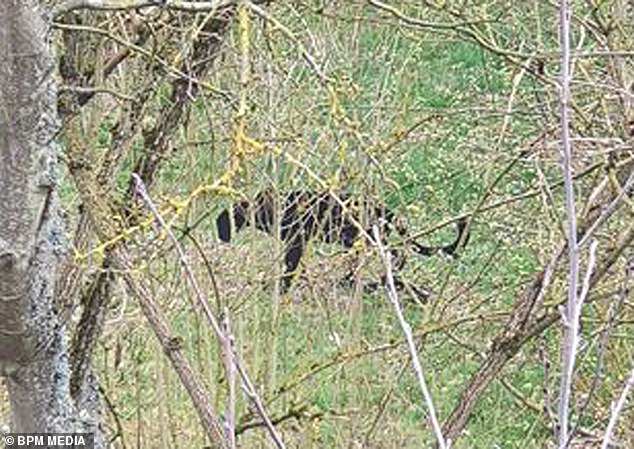Fears black panther is on the loose in Gloucestershire after walker captures prowling ‘big cat’ on camera
- The animal was spotted in woodland in the village of Thrupp near Stroud
- A big cat expert has suggested the animal has the hallmarks of a black panther
- Comes amid a spate of reported sightings of pumas in the Welsh countryside
Experts have suggested a black panther could be on the loose after a walker spotted a ‘big cat’ on camera.
The animal was spotted in woodland in the village of Thrupp near Stroud in Gloucestershire, yesterday morning.
Frank Tunbridge, who has spent decades investigating sightings of big cats in the British countryside, claimed the ‘streamlined’ animal ‘exhibits all the features of a black panther.’

The creature was seen in fields just outside Stroud yesterday at around 11am, and the man who captured the image is ‘convinced’ the animal was a big cat

A big cat expert says the ‘streamlined’ animal ‘exhibits all the features of a black panther’
The animal was spotted in a field surrounded by trees near Stroud by the onlooker, who says he was just 100 yards away when he captured the picture on his phone.
The man, who asked to remain anonymous, said: ‘I’m unsure what the animal was but it was certainly feline in it’s movement.
‘My first thought was that it was a family dog that had got out, so initially I wasn’t scared at all, but once I realised what it could be I snapped a couple of pics and quickly retreated.
‘I’ve never seen an animal like it before but it seems plausible that a large cat could be roaming the countryside.
‘It seemed to be playful and completely unaware of me in the minute or so that I observed it.’
Experts recently suggested pumas were behind a spate of sheep deaths in Wales, after examination of the corpses revealed they were ‘clinically’ killed – unlike a random dog attack.
There have been a series of reports made to the Puma Watch North Wales group since November.
A farmer found seven sheep slaughtered in his field in Snowdonia while other farmers in the area have also raised concerns over the way their livestock had been killed.
Big claw marks were also discovered – up to six feet above the ground – on trees. Big cats are thought to do this to sharpen their claws and warn off other predators.
Big cat enthusiast Frank Tunbridge has been studying the animals for some 25 years.
Mr Tunbridge believes big cats were released into the wild in the UK during and after the Dangerous Animals Act which was introduced in 1976.
The 73-year-old, from Podsmead in Gloucester, said: ‘This photo exhibits all the features of an Asian melanistic black leopard, sometimes referred to as a black panther.
‘The long tail with a slight tuft on the end is diagnostic to leopards.
‘However, this photo reveals a creature that has adapted to living and hunting fast moving deer in the UK.
‘It is slim, streamlined, long legged, with a smallish head, but still an efficient predator which has the tools for the job, with the teeth and claws.
‘This particular type of British big cat, like the one in the photo, reflects at least 80 per cent of the sightings that I have received over the years and, if genuine, now gives credence to either natural adaptation of a species, or a hybrid animal now breeding true to type and living and breeding within the British Isles.’
The eyewitness added: ‘I have heard that there have been similar sightings around the Stroud area. I decided I had to take the picture because I didn’t think anyone would believe me.
‘Two colleagues were with me but didn’t see the animal for themselves as they were working a few metres from me, they were in disbelief at the pictures.
‘I’ve no intention of going to find the creature again but I do regularly work in the area so I will most definitely be making sure I’ve got my wits about me.’

The real deal: A ‘black panther’ is not actually its own species—it is an umbrella term that refers to any big cat with a black coat
There have been similar claimed sightings of reported ‘big cats’ in the area over the years.
In 2018 Guillaume Lyons claims he saw a big cat on the tow path just down the road from this sighting, in Brimscombe.
Advertisement




